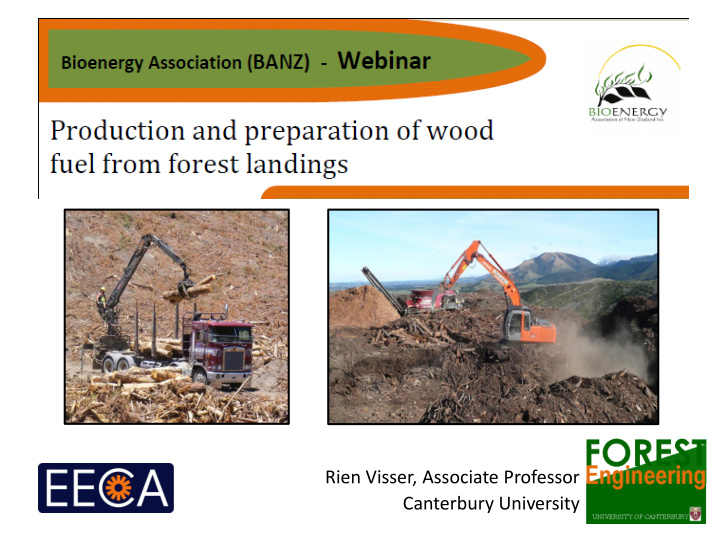



Rien Visser, Associate Professor Canterbury University
Overview – Wood Fuel from Landings • Wood Fuel (woody-biomass) and NZ forestry operations • International developments • Production Case Studies • Biomass preparation options - drying / covering (Visser, Hall and Raymond, 2010)
Woody Biomass at Forest Landings: We know its out there... • Approx 1.6 million tons of ‘residues’ per year at landing… Potential for further increase: • More harvesting, in more remote areas • Greater focus on mechanised felling and processing • Declining wood fibre markets
So how can we get it?
NZ Situation… ‘Wood Fuel’ Contractors Energy Forestry Market Companies (demand) (supply)
Europe… Wood Fuel Contractors Energy Forestry Market Companies (demand) (supply)
Be careful in looking overseas.. i.e. Austria Heat Heat + Electricity
However, lot of commonality with Southern USA… • Similar pine plantations + large scale thinning / chipping operations + residue collection from landings • Wood fuel market (1) long established wood processing plants, (2) coal co-firing for electricity, (3) pellets for Europe
Need quality product – market driven Ideal Consumer Situation - Reliable supply of quality, suitable product - Payment that correlates to quality and energy content of product Ideal Contractor Situation - Consistent volumes of uncontaminated material for comminution - Integrated into forest management - Revenue incentives to produce high quality fuel Ideal Forest Owner Situation - Consistent revenue from woody biomass recovery - Well organised integrated forest mgmt activity - Maximise positive benefits (improved planting, reduced fire risk)
Need quality product – market driven Ideal Consumer Situation - Reliable supply of quality, suitable product - Payment that correlates to quality and energy content of product Ideal Contractor Situation - Consistent volumes of uncontaminated material for comminution - Integrated into forest management - Revenue incentives to produce high quality fuel Ideal Forest Owner Situation - Consistent revenue from woody biomass recovery - Well organised integrated forest mgmt activity - Maximise positive benefits (improved planting, reduced fire risk)
Integrated into forest management… Extract and stack the slash then chip and truck from the harvesting operations, to marketroadside
EECA / UC research project • Study NZ Wood Fuel Contractors – System productivity – Delivered wood fuel cost • Finding common elements for success…. (because not being successful is typically very expensive!) • Biomass operation at Sefton MDF plant – 2008)
Case Study 1: Canterbury • Large scale wood fuel recovery from super-skid Hog fuel to local large industrial plant
Case Study 1: Canterbury - Results • Wood in contact with ground does not dry and becomes contaminated • High system cost & low operational efficiency Be work opportunistic... i.e. Clearing dairy farm shelter belts
Case Study 2: BOP • Extracting residue logs from wind-throw areas.. Chips and firewood to regional customers
Case Study 2: BOP - Results • 70% of the volume is in 25% of the pieces • Simplify business model... be equipment opportunistic!
Not all wood fuel is equal... • A lot of landing residue is both ‘wet’ and ‘contaminated’… • Problem: currently most contractors are paid on ‘weight’ --> water and dirt are heavier than wood! • High moisture content low energy content • Contamination high ash content
Case Study 3: Dunedin Large scale recovery of residue logs for centralised processing... high quality wood chip for district heat market
Case Study 3: Dunedin - Results • Log drying trial... (Visser, Berkett and Spinelli, 2014) Results: 1. Excellent drying in summer in exposed location 2. Covering slows drying in summer, but keeps from wetting in winter. 3. Large diameter logs benefit greatly from splitting, but cannot justify cost ($10/m3).
Log Drying cost / benefit? • Double handling and storage costs and risks? • Comminution costs? dryer logs increases knife wear and fuel use, esp. with chippers.
Case Study 4: Oamaru • Integrated production contractor manages both harvesting systems and firewood recovery • Market opportunity – landing residue++ firewood
Case Study 4: Oamaru • Use older landings and simple but effective supply chain • Relatively high quality satisfied customers
Delivery cost of Wood Fuel Energy Case Study Canterbury BOP Dunedin Oamaru Daily Cost $3,025 $2,050 $2,125 $1,240 Daily 75 t 62.5 t 125 t 15 t Production Cost per ton $45 $29 $17 $42 Cost per GJ $6.50 $3.55* $2.20* $5.54 * Not comminuted
Conclusions - Wood Fuel from Landings For user or supplier... • Forest residues source of large volumes of wood fuel • Be familiar with wood fuel characteristics pay for energy, not for water and dirt For wood fuel contractor… • Know your market demands – focus on suitable product • Keep operation simple and be opportunistic For forest owner… • Integrate wood fuel recovery operations • Understand (and help optimise) supply chain
Recommend
More recommend